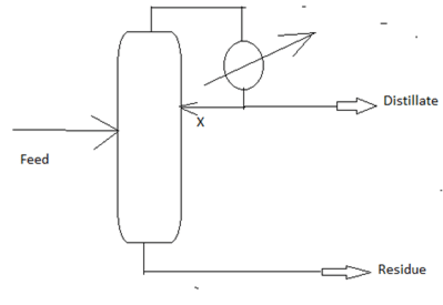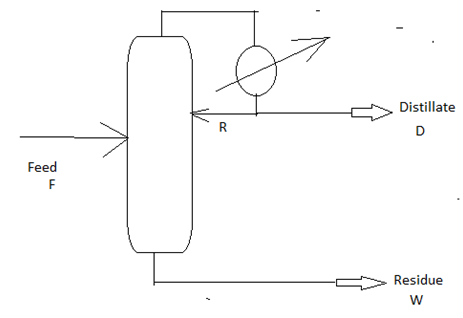This set of Mass Transfer online test focuses on “Continuous Fractionation Operation of Distillation Column”.
1. Rectifying continuously is known as _____________
a) Partialization
b) Fractionation
c) Condensation
d) None of the mentioned
View Answer
Explanation: Fractionation is the continuous separation of volatile component.
2. The top of the fractionators has ______ temperature.
a) High
b) Low
c) No
d) None of the mentioned
View Answer
Explanation: To maintain the dew point we need to have a low temperature.
3. The section above the feed tray in a fractionator is known as ______________
a) Enriching section
b) Rectifying section
c) Feed section
d) All of the mentioned
View Answer
Explanation: The enriching section where the low volatile components are absorbed in the liquid condensed.
4. The notation X from the figure below is known as Reflux.

a) True
b) False
View Answer
Explanation: Some part of the condensed product are sent back to the rectifying column for the effective separation is known as reflux.
5. The bottom of the fractionators has a ______ temperature.
a) High
b) Low
c) No
d) None of the mentioned
View Answer
Explanation: To maintain the bubble point we need to have a high temperature.
6. The section below the feed tray in a fractionator is known as ______________
a) Enriching section
b) Rectifying section
c) Feed section
d) All of the mentioned
View Answer
Explanation: The rectifying section where the high volatile components are stripped from the liquid condensed.
7. Express the reflux ratio

a) D/F
b) R/D
c) R/W
d) R/F
View Answer
Explanation: The reflux ratio is the ratio of reflux(R) to the Distillate(D).
8. The use of vapour produced from the reboiler is
a) To strip out more volatile component from liquid
b) To strip out low volatile component from the liquid
c) To increase the temperature of the fractionator bottom
d) None of the mentioned
View Answer
Explanation: The vapour from the stripping section strips the more volatile component to form distillate.
9. The light key components are__________
a) More volatile
b) Less volatile
c) Non volatile
d) None of the mentioned
View Answer
Explanation: Since the light key components have a low boiling point it is a more volatile component.
10. Find the reflux ratio if the feed , residue and reflux rate is 100, 40 and 50 mole/hr.
a) 1.25
b) 0.83
c) 1.5
d) 1
View Answer
Explanation: Reflux ratio = reflux/distillate
Distillate= 100-40=60
Reflux ratio= 50/60 = 0.83.
11. The residue has a more heavy key component.
a) True
b) False
View Answer
Explanation: The heavy key (low volatile) components are more in the bottom residue.
Sanfoundry Global Education & Learning Series – Mass Transfer.
To practice all areas of Mass Transfer for online test, here is complete set of 1000+ Multiple Choice Questions and Answers
If you find a mistake in question / option / answer, kindly take a screenshot and email to [email protected]
- Practice Chemical Engineering MCQs
- Check Chemical Engineering Books
- Practice Mechanical Engineering MCQs
- Apply for Mechanical Engineering Internship
- Check Mechanical Engineering Books
